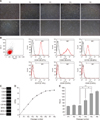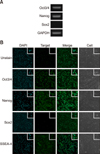1. Abt M, de Jonge J, Laue M, Wolff T. Improvement of H5N1 influenza vaccine viruses: influence of internal gene segments of avian and human origin on production and hemagglutinin content. Vaccine. 2011; 29:5153–5162.

2. Aggarwal S, Dewhurst S, Takimoto T, Kim B. Biochemical impact of the host adaptation-associated PB2 E627K mutation on the temperature-dependent RNA synthesis kinetics of influenza A virus polymerase complex. J Biol Chem. 2011; 286:34504–34513.

3. Bhat S, Bhatia S, Pillai AS, Sood R, Singh VK, Shrivas OP, Mishra SK, Mawale N. Genetic and antigenic characterization of H5N1 viruses of clade 2.3.2.1 isolated in India. Microb Pathog. 2015; 88:87–93.

4. Bodewes R, Kreijtz JH, Baas C, Geelhoed-Mieras MM, de Mutsert G, van Amerongen G, van den Brand JM, Fouchier RA, Osterhaus AD, Rimmelzwaan GF. Vaccination against human influenza A/H3N2 virus prevents the induction of heterosubtypic immunity against lethal infection with avian influenza A/H5N1 virus. PLoS One. 2009; 4:e5538.

5. Choi JG, Kang HM, Jeon WJ, Choi KS, Kim KI, Song BM, Lee HS, Kim JH, Lee YJ. Characterization of clade 2.3.2.1 H5N1 highly pathogenic avian influenza viruses isolated from wild birds (mandarin duck and Eurasian eagle owl) in 2010 in Korea. Viruses. 2013; 5:1153–1174.

6. Choi JG, Lee YJ, Kim YJ, Lee EK, Jeong OM, Sung HW, Kim JH, Kwon JH. An inactivated vaccine to control the current H9N2 low pathogenic avian influenza in Korea. J Vet Sci. 2008; 9:67–74.

7. Choi YK, Seo SH, Kim JA, Webby RJ, Webster RG. Avian influenza viruses in Korean live poultry markets and their pathogenic potential. Virology. 2005; 332:529–537.

8. Fornek JL, Gillim-Ross L, Santos C, Carter V, Ward JM, Cheng LI, Proll S, Katze MG, Subbarao K. A single-amino-acid substitution in a polymerase protein of an H5N1 influenza virus is associated with systemic infection and impaired T-cell activation in mice. J Virol. 2009; 83:11102–11115.

9. Hamilton MA, Russo RC, Thurston RV. Trimmed Spearman-Karber method for estimating median lethal concentrations in toxicity bioassays. Environ Sci Technol. 1977; 11:714–719.

10. Hatta M, Hatta Y, Kim JH, Watanabe S, Shinya K, Nguyen T, Lien PS, Le QM, Kawaoka Y. Growth of H5N1 influenza A viruses in the upper respiratory tracts of mice. PLoS Pathog. 2007; 3:1374–1379.

11. Hoffmann E, Krauss S, Perez D, Webby R, Webster RG. Eight-plasmid system for rapid generation of influenza virus vaccines. Vaccine. 2002; 20:3165–3170.

12. Hoffmann E, Stech J, Guan Y, Webster RG, Perez DR. Universal primer set for the full-length amplification of all influenza A viruses. Arch Virol. 2001; 146:2275–2289.

13. Kim IH, Choi JG, Lee YJ, Kwon HJ, Kim JH. Effects of different polymerases of avian influenza viruses on the growth and pathogenicity of A/Puerto Rico/8/1934 (H1N1)-derived reassorted viruses. Vet Microbiol. 2014; 168:41–49.

14. Kim IH, Kwon HJ, Choi JG, Kang HM, Lee YJ, Kim JH. Characterization of mutations associated with the adaptation of a low-pathogenic H5N1 avian influenza virus to chicken embryos. Vet Microbiol. 2013; 162:471–478.

15. Kim IH, Kwon HJ, Kim JH. H9N2 avian influenza virus-induced conjunctivitis model for vaccine efficacy testing. Avian Dis. 2013; 57:83–87.

16. Kim IH, Kwon HJ, Lee SH, Kim DY, Kim JH. Effects of different NS genes of avian influenza viruses and amino acid changes on pathogenicity of recombinant A/Puerto Rico/8/34 viruses. Vet Microbiol. 2015; 175:17–25.

17. Kim IH, Kwon HJ, Park JK, Song CS, Kim JH. Optimal attenuation of a PR8-derived mouse pathogenic H5N1 recombinant virus for testing antigenicity and protective efficacy in mice. Vaccine. 2015; 33:6314–6319.

18. Kim JH, Hatta M, Watanabe S, Neumann G, Watanabe T, Kawaoka Y. Role of host-specific amino acids in the pathogenicity of avian H5N1 influenza viruses in mice. J Gen Virol. 2010; 91:1284–1289.

19. Kreijtz JH, Bodewes R, van Amerongen G, Kuiken T, Fouchier RA, Osterhaus AD, Rimmelzwaan GF. Primary influenza A virus infection induces cross-protective immunity against a lethal infection with a heterosubtypic virus strain in mice. Vaccine. 2007; 25:612–620.

20. Kwon HJ, Cho SH, Ahn YJ, Kim JH, Yoo HS, Kim SJ. Characterization of a chicken Embryo-Adapted H9N2 subtype avian influenza virus. Open Vet Sci J. 2009; 3:9–16.

21. Lee DH, Park JK, Youn HN, Lee YN, Lim TH, Kim MS, Lee JB, Park SY, Choi IS, Song CS. Surveillance and isolation of HPAI H5N1 from wild Mandarin Ducks (
Aix galericulata). J Wildl Dis. 2011; 47:994–998.

22. Lee DH, Song CS. H9N2 avian influenza virus in Korea: evolution and vaccination. Clin Exp Vaccine Res. 2013; 2:26–33.

23. Lee EK, Kang HM, Kim KI, Choi JG, To TL, Nguyen TD, Song BM, Jeong J, Choi KS, Kim JY, Lee HS, Lee YJ, Kim JH. Genetic evolution of H5 highly pathogenic avian influenza virus in domestic poultry in Vietnam between 2011 and 2013. Poult Sci. 2015; 94:650–661.

24. Mo IP, Bae YJ, Lee SB, Mo JS, Oh KH, Shin JH, Kang HM, Lee YJ. Review of Avian Influenza Outbreaks in South Korea from 1996 to 2014. Avian Dis. 2016; 60:1 Suppl. 172–177.

25. Moon HJ, Song MS, Cruz DJ, Park KJ, Pascua PN, Lee JH, Baek YH, Choi DH, Choi YK, Kim CJ. Active reassortment of H9 influenza viruses between wild birds and live-poultry markets in Korea. Arch Virol. 2010; 155:229–241.

26. Partridge J, Kieny MP. World Health Organization H1N1 influenza vaccine Task Force. Global production of seasonal and pandemic (H1N1) influenza vaccines in 2009-2010 and comparison with previous estimates and global action plan targets. Vaccine. 2010; 28:4709–4712.

27. Pflug A, Guilligay D, Reich S, Cusack S. Structure of influenza A polymerase bound to the viral RNA promoter. Nature. 2014; 516:355–360.

28. Ping J, Lopes TJ, Nidom CA, Ghedin E, Macken CA, Fitch A, Imai M, Maher EA, Neumann G, Kawaoka Y. Development of high-yield influenza A virus vaccine viruses. Nat Commun. 2015; 6:8148.

29. Reid SM, Shell WM, Barboi G, Onita I, Turcitu M, Cioranu R, Marinova-Petkova A, Goujgoulova G, Webby RJ, Webster RG, Russell C, Slomka MJ, Hanna A, Banks J, Alton B, Barrass L, Irvine RM, Brown IH. First reported incursion of highly pathogenic notifiable avian influenza A H5N1 viruses from clade 2.3.2 into European poultry. Transbound Emerg Dis. 2011; 58:76–78.

30. Rott R. The pathogenic determinant of influenza virus. Vet Microbiol. 1992; 33:303–310.

31. Senne DA, Panigrahy B, Kawaoka Y, Pearson JE, Süss J, Lipkind M, Kida H, Webster RG. Survey of the hemagglutinin (HA) cleavage site sequence of H5 and H7 avian influenza viruses: amino acid sequence at the HA cleavage site as a marker of pathogenicity potential. Avian Dis. 1996; 40:425–437.

32. Steel J, Lowen AC, Mubareka S, Palese P. Transmission of influenza virus in a mammalian host is increased by PB2 amino acids 627K or 627E/701N. PLoS Pathog. 2009; 5:e1000252.

33. Steinhauer DA. Role of hemagglutinin cleavage for the pathogenicity of influenza virus. Virology. 1999; 258:1–20.

34. Stephenson I, Gust I, Pervikov Y, Kieny MP. Development of vaccines against influenza H5. Lancet Infect Dis. 2006; 6:458–460.

35. Swayne DE. Impact of vaccines and vaccination on global control of avian influenza. Avian Dis. 2012; 56:4 Suppl. 818–828.

36. Swayne DE, Pavade G, Hamilton K, Vallat B, Miyagishima K. Assessment of national strategies for control of high-pathogenicity avian influenza and low-pathogenicity notifiable avian influenza in poultry, with emphasis on vaccines and vaccination. Rev Sci Tech. 2011; 30:839–870.

37. Taylor PM, Askonas BA. Influenza nucleoprotein-specific cytotoxic T-cell clones are protective in vivo. Immunology. 1986; 58:417–420.
38. Tong S, Li Y, Rivailler P, Conrardy C, Castillo DA, Chen LM, Recuenco S, Ellison JA, Davis CT, York IA, Turmelle AS, Moran D, Rogers S, Shi M, Tao Y, Weil MR, Tang K, Rowe LA, Sammons S, Xu X, Frace M, Lindblade KA, Cox NJ, Anderson LJ, Rupprecht CE, Donis RO. A distinct lineage of influenza A virus from bats. Proc Natl Acad Sci U S A. 2012; 109:4269–4274.

39. Webster RG, Bean WJ, Gorman OT, Chambers TM, Kawaoka Y. Evolution and ecology of influenza A viruses. Microbiol Rev. 1992; 56:152–179.

40. World Health Organization/World Organisation for Animal Health/Food and Agriculture Organization (WHO/OIE/FAO) H5N1 Evolution Working Group. Revised and updated nomenclature for highly pathogenic avian influenza A (H5N1) viruses. Influenza Other Respir Viruses. 2014; 8:384–388.









 PDF
PDF ePub
ePub Citation
Citation Print
Print




 XML Download
XML Download